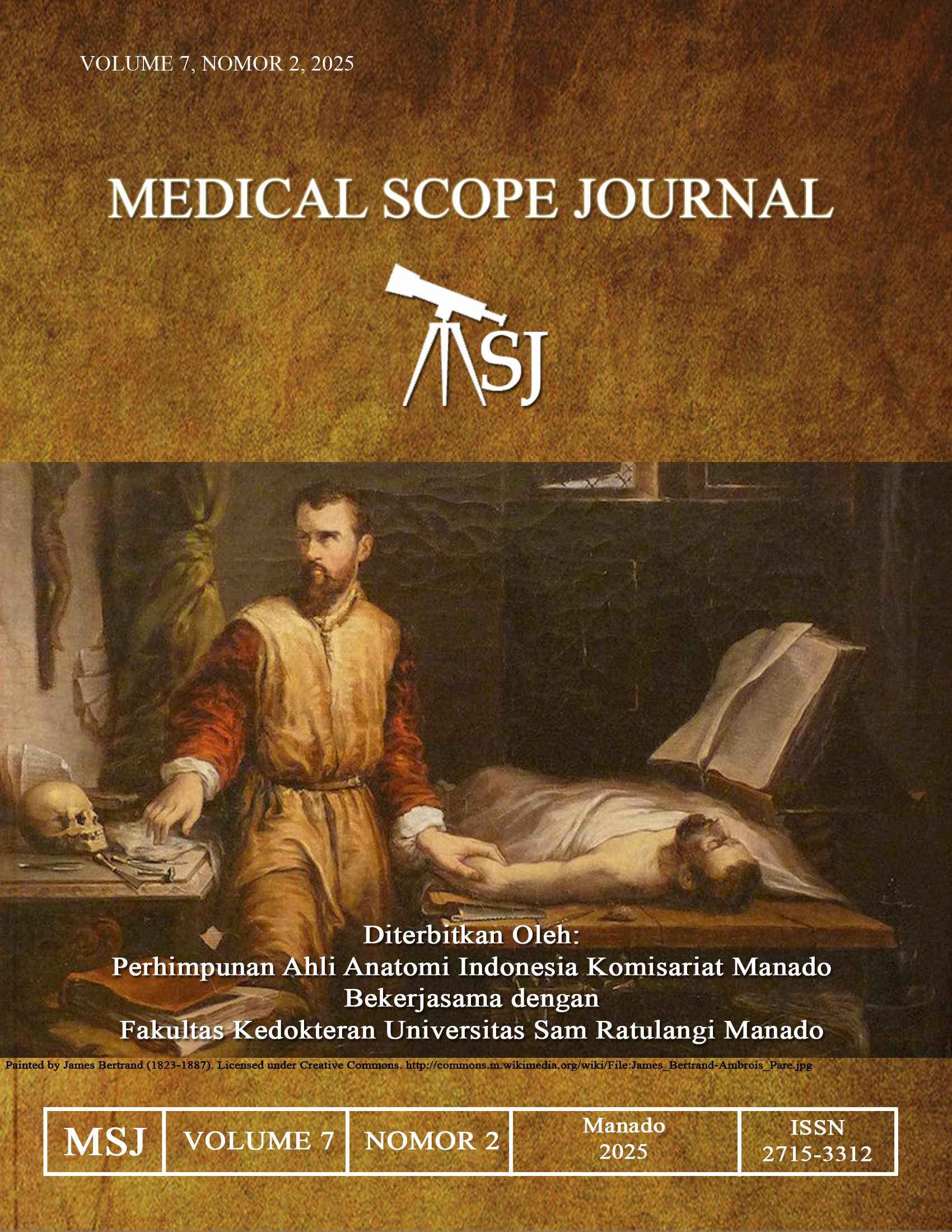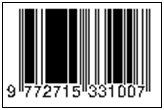Scalp Defect of Cranioplasty with Titanium Mesh: A Case Report
DOI:
https://doi.org/10.35790/msj.v7i2.59703Abstract
Abstract: Several implant materials for cranioplasty have been studied, including autologous bone, titanium mesh, polyetheretherketone (PEEK), and polymethyl methacrylate (PMMA). Titanium mesh is believed to have excellent biocompatibility, low cost, and satisfactory cosmetic effects, especially in three-dimensional (3D) custom-made meshes. We reported a 54-year-old man complaining of open wound in his left temporoparietal region since a month. Blood tests showed leukocytosis. Patient was diagnosed as scalp infection with previous cranioplasty using bone cement on temporoparietal region. The patient underwent scalp reconstruction with skin flap, removing skin defect, and split thickness skin graft (STSG) from left thigh. Patient was provided with outpatient medication consisting of analgesics and broad-spectrum antibiotics. Follow-up assessment 14 days after surgery did not reveal any secondary infections on titanium mesh implant and skin flap. The main complications of cranioplasty, in addition to the studied aesthetic results, are represented by the risk of infection, postoperative hematoma, impaired wound healing, as well as prolonged failure due to transplant absorption or infection, as a result of which the prosthesis needs to be removed. In conclusion, titanium mesh is still a better choice of material for cranioplasty in many factors such as price, accessibility, infection rate, and biocompatibility
Keywords: scalp; cranioplasty; head injury; prosthesis
References
Jonkergouw J, van de Vijfeijken SE, Nout E, Theys T, Casteele EV, et al. Outcome in patient-specific PEEK cranioplasty: a twocenter cohort study of 40 implants. J Craniomaxillofac Surg. 2016;44(103):1266– 72. Doi: 10.1097/SAP.0000000000001559
Malcolm JG, Rindler RS, Chu JK, Chokshi F, Grossberg JA, Pradilla G, et al. Early cranioplasty is associated with greater neurological improvement: a systematic review and meta-analysis. Neurosurgery. 2018; 82(3):278–88. Doi: 10.1093/neuros/nyx182
De Cola MC, Corallo F, Pria D, Buono VL, Calabro RS. Timing for cranioplasty to improve neurological outcome: a systematic review. Brain Behav. 2018;8(11):e01106. Doi: 10.1002/brb3.1106
Kwiecien GJ, Rueda S, Couto RA, Hashem A, Nagel S, Schwarz GS, et al. Long-term outcomes of cranioplasty: titanium mesh is not a long-term solution in high-risk patients. Ann Plast Surg. 2018;81(4):416– 22. Doi: 10.1097/SAP.0000000000001559.
Morselli C, Zaed I, Tropeano MP, Cataletti G, Laccarino C, Rossini Z, et al. Comparison between the different types of heterologous materials used in cranioplasty: a systematic review of the literature. J Neurosurg Sci. 2019;63(6):723–36. Doi: 10.23736/S0390-5616.19.04779-9
Honeybul S, Morrison DA, Ho KM, Lind CRP, Geelhoed E. A randomized controlled trial comparing autologous cranioplasty with custom-made titanium cranioplasty. J Neurosurg. 2017;126(134):81–90. Doi: 10.3171/2015.12.JNS152004
Leão RS, Maior JRS, Lemos CAA, Vasconcelos BCE, Montes MAJR, Pellizzer EP, et al. Complications with PMMA compared with other materials used in cranioplasty: a systematic review and meta-analysis. Braz Oral Res. 2018;32:e31. Doi: 10.1590/1807-3107bor-2018.vol32.0031
Malcolm JG, Mahmooth Z, Rindler RS, Allen JW, Grossberg JA, et al. Autologous cranioplasty is associated with increased implant failure rate: a systematic review and meta-analysis. World Neurosurg. 2018;116 :60– 8. Doi: 10.1016/j.wneu.2018.05.009
Corliss B, Gooldy T, Vaziri S, Kubilis P, Murad G, Fargen K. Complications after in vivo and ex vivo autologous bone flap storage for cranioplasty: A comparative analysis of the literature. World Neurosurg. 2016;96:510-5. Doi: 10.1016/j.wneu.2016.09.025
Kim JK, Lee SB, Yang SY. Cranioplasty using autologous bone versus porous polyethylene versus custom-made titanium mesh: a retrospective review of 108 patients. J Korean Neurosurg Soc. 2018; 61(31):737-46. Doi: 10.3340/jkns.2018.0047
Matsuno A, Tanaka H, Iwamuro H, Miyawaki S, Nakashima M, Nakaguchi H, et al. Analyses of the factors influencing bone graft infection after delayed cranioplasty. Acta Neurochir (Wien) 2006;148(5):535-40. Doi: 10.1007/s00701-006-0740-6
Van de Vijfeijken SE, Münker TJ, Spijker R, Karssemakers LHE, Vandertop WP, Becking AG, et al. Autologous bone is inferior to alloplastic cranioplasties: Safety of autograft and allograft materials for cranioplasties, a systematic review. World Neurosurg 2018;117:443-52.e8. Doi: 10.1016/j.wneu.2018.05.193
Policicchio D, Casu G, Dipellegrini G, Doda A, Muggianu G, Boccaletti R. Comparison of two different titanium cranioplasty methods: custom-made titanium prostheses versus precurved titanium mesh. Surg Neurol Int. 2020;11:148. Doi: 10.25259/SNI_35_2020
Yang J, Sun T, Yuan Y, Li X, Yu H, Guan J. Evaluation of titanium cranioplasty and polyetheretherketone cranioplasty after decompressive craniectomy for traumatic brain injury: a prospective, multicenter, non-randomized controlled trial. Medicine. 2020;99(30):e21251. Doi: 10.1097/MD.0000000000021251
Yao S, Zhang Q, Mai Y, Yang H, Li Y, Zhang M, et al. Outcome and risk factors of complications after cranioplasty with polyetheretherketone and titanium mesh: A single-center retrospective study. Front. Neurol. 2022;13:926436. Doi: 10.3389/fneur.2022.926436
Falguera MI, Sánchez S, Escudero C, Escudero-Duch C, Vilaoa N. A narrative review of cell-based approaches for cranial bone regeneration. Pharmaceutics. 2022;14(1):132 Doi: 10.3390/pharmaceutics14010132
Rosinski CL, Patel S, Geever B, Chiu RG, Chaker AN, Zakrzewski J, et al. A retrospective comparative analysis of titanium mesh and custom implants for cranioplasty. Neurosurgery. 2020;86(1):E15-E22. Doi: 10.1093/neuros/nyz358
Oliver JD, Banuelos J, Abu-Ghname A, Vyas KS, Sharaf B. Alloplastic cranioplasty reconstruction: a systematic review comparing outcomes with titanium mesh, polymethyl methacrylate, polyether ether ketone, and norian implants in 3591 adult patients. Ann Plast Surg 2019;82(62):S289–S294, Doi: 10.1097/SAP.0000000000001801
Downloads
Published
How to Cite
Issue
Section
License
Copyright (c) 2025 Antonius E. Sonbay, Eko Prasetyo, Maximillian C. Oley, Yovanka Manuhutu, Ferdinan Tjungkagi

This work is licensed under a Creative Commons Attribution-NonCommercial 4.0 International License.
COPYRIGHT
Authors who publish with this journal agree to the following terms:
Authors hold their copyright and grant this journal the privilege of first publication, with the work simultaneously licensed under a Creative Commons Attribution License that permits others to impart the work with an acknowledgment of the work's origin and initial publication by this journal.
Authors can enter into separate or additional contractual arrangements for the non-exclusive distribution of the journal's published version of the work (for example, post it to an institutional repository or publish it in a book), with an acknowledgment of its underlying publication in this journal.
Authors are permitted and encouraged to post their work online (for example, in institutional repositories or on their website) as it can lead to productive exchanges, as well as earlier and greater citation of the published work (See The Effect of Open Access).










